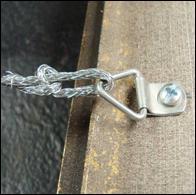 Photo 1
Photo 1
Wire attached with half hitch ready to slip and/or fail.
As with any introduction—you only have one chance to make a good first impression, and a collector may fall in love with your art, but if the quality of your framing does not match the quality of your art, it is not a complete package. Whether professionally framed or framed by you, it's the little things that give any framed art a polished look, and your displayed pieces should have the same top notch appearance from all angles—front, sides and back. These few tips will help you make a good impression while also caring for the hanging longevity of your art.
The Knot
Even though the half hitch has many uses, it has no place in the securing of wire to the back of any frame (photo 1). The wire has not been pulled snugly which could result in the wire either slipped once hung and/or totally pulling from the D-ring. All wires are best attached with a lark's head knot (photo 2), originally discussed in my July column "Proper Wire Installation". Though this know will hold securely it should still be twisted around the hanging wire for maximum security. An untwisted wire might readily hold a five pound cradle, but a 40 pound piece would really stress the knot.
 Photo 1
Photo 1
Wire attached with half hitch ready to slip and/or fail.
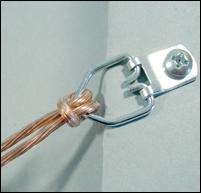 Photo 2
Photo 2
Wire properly attached using lark's head.
The Twist
The type of wire twists is as important as the knot. A loosely twisted wire not only allows for slippage but also has a sloppy, unprofessional appearance (photo 3). Add loose wire coils to no locking knot and the wire may fail by pulling from the riveted D-ring on this commercial ready-made frame backing. Not a good image for any professional artist. Compacting the wire twists together gives both security and a clean, finished, professional look (photo 4).
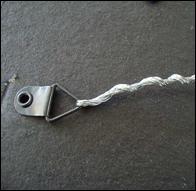 Photo 3
Photo 3
A loosely twisted wire can also slip if the art is heavy.
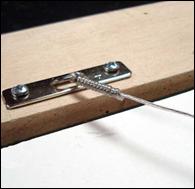 Photo 4
Photo 4
Wind the wire 10-12 times tightly around the wire and compact the winds together.
The Hanger
I will be writing another article on the issue of frame depth later this year, but for now let's address what's wrong here. There are two issues here—the unsecured screweye and the fact the frame is too shallow for the stretched canvas it is housing. When a frame is not deep enough to fully protect the art a number of problems occurs. In the sample photo 5 the screweye has been left only partially threaded in an attempt raise the wire to the level of the back of the canvas bars, but in the process this artist has compromised the strength of the hanger. Screweyes begin as a weak link (see "Off With Their Heads", May 2011) any one not fully threaded is the worst.
 Photo 5
Photo 5
Screw eye only partially threaded will pull from wood frame.
When a wire is stretched around—or over—the edge of an extended cradle or canvas it becomes a stress point for the wire itself. That added to the extra pull on the hanger sets the stage for a broken wire, screws that pull out, snapped screweye necks, frame twisting, and the art floating too far off the wall. None of these are a good thing.
There is no good solution to a shallow frame, but steel plates with multiple screws and a lark's head wire mount with secure twisted wire will hold best and reduce hanger stresses (photo 6), but will never resolve the presentation of floating off the wall.
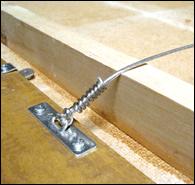 Photo 6
Photo 6
Steel plate for stability and extra stresses.
END
Copyright © 2012 Chris A Paschke
For more articles on mounting basics look under the mounting section in Articles by Subject.
There is a special section in the library for all past IEA Framing Matters articles from Wax-On!
Additional information on all types of mounting is found in:
The Mounting and Laminating Handbook, Second Edition, 2002,
The Mounting And Laminating Handbook, Third Edition, 2008 and
Creative Mounting, Wrapping, And Laminating, 2000 will teach you everything you need to know about getting the most from your dry mount equipment and materials as an innovative frame designer.
All books are available from Designs Ink Publishing through this website.
Chris A Paschke, CPF GCF
Designs Ink
Designs Ink Publishing
785 Tucker Road, Suite G-183
Tehachapi, CA 93561
P 661-821-2188
chris@designsinkart.com